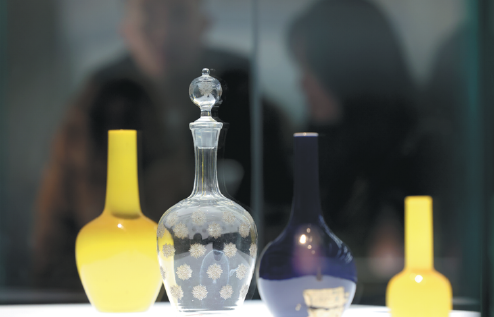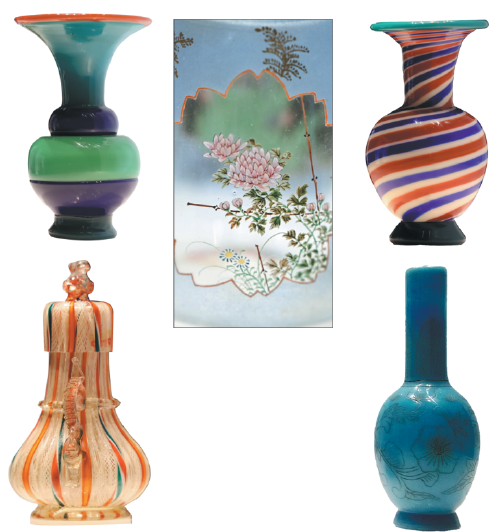A glass apart
Exquisite pieces of glassware from the Palace Museum's collection, dating back to the 17th century and embodying the creativity born of cooperation between artisans from the East and the West, go on display in Beijing, Lin Qi reports.

Of the European missionaries serving at the court of Qing Dynasty (1644-1911) Emperor Kangxi, Bernard-Kilian Stumpf (1655-1720), from Wurzburg, in what is now Germany, was a notable figure. His wide-ranging knowledge and versatility impressed the emperor — he was good at maths, astronomy and machinery fabrication.
What Kangxi appreciated most, though, was Stumpf's gift in mastering glassmaking techniques. The emperor, who had a keen interest in Western arts, crafts and science, designated the German missionary to head his glassworks, situated in an alley not far from the Forbidden City, and to innovate the presentation of glass art.
In the years he dedicated to technical progress at Kangxi's workshop, Stumpf achieved success in propelling the artistry of imperial glassware to a new height. Meanwhile, he helped train Chinese glass artisans who, after his death, continued to develop new methods in the field and create beautiful objects.
Today, fine examples of glassware once made under the watchful eye of Stumpf, or by his Chinese proteges, have left their home at the Palace Museum and are on show a mere kilometer away in an ongoing exhibition, Crystal and Majestic, at Guardian Art Center in Beijing, which runs through to Sunday.
The exhibition shows more than 120 glass objects, dating from the 17th to 20th centuries, from the collection of Palace Museum, demonstrating the variety of colors, shapes and techniques of glassmaking in China and Europe, and in what ways these glittering objects enriched the living spaces of the imperial palace. It is the fifth collaboration between Guardian Art Center and the Palace Museum to showcase part of the latter's immense collection of imperial art.
According to Zhang Rong, a researcher at the Palace Museum with expertise in glassware, the museum has in its collection more than 4,000 glass objects, over 90 percent of which formerly ornamented the living space of the Qing rulers.
Also the exhibition's academic consultant, Zhang says "the exhibition shows three major sources of the glassware once housed at the Forbidden City: zaobanchu, or the imperial workshop (to which the glassworks affiliated), tributes to the royal family from outside the imperial palace and exports from abroad".
The history of glassmaking in China can be traced to the Western Zhou Dynasty (c. 11th century-771 BC). The establishment of glassworks in 1696, ordered by Kangxi himself, opened up a new chapter, in which the glass art was leveraged to its peak, technically and aesthetically.
The imperial workshops became a melting pot of the East and the West: New technologies were introduced by European missionaries, while home-grown artisans from long-standing glassmaking hubs, such as Boshan in Shandong province, were motivated to develop new combinations of color and motif.
The objects on show demonstrate well this exchange between two cultures. Products from the reigns of Kangxi, his son Yongzheng and grandson Qianlong — all avid patrons of art and crafts — present the same majestic beauty and imposing dignity as other artworks of the time; they were also the fruits of the cooperation between European and Chinese technicians to invent new styles.
One of the highlights at the exhibition, Zhang says, is a red and white brush-pen holder which employs the cased-glass technique. Such glass has two or more layers of different colors.
Zhang says the holder is actually half done, for the outer layer of glass, according to documents kept at the zaobanchu workshop, should be further carved with relief details, done in the same way as the traditional jade carving. Examples of the same kind of glass with the reliefs can be found in the collections of institutions such as the Museum of Fine Arts, Boston.
Among the many delicate works of art invented during the time of Emperor Qianlong, what prized above all others was arguably the "gold star glass", as it was highly appreciated by Qianlong who, on occasion, personally supervised its production.
The name was derived from the process, through which metal powders were added and the finished glass yielded shimmering, reflective properties. The technical difficulty makes this type of glass a rarity — there are no more than 40 examples of it in Palace Museum's collection.
Glass artisans working at the imperial workshop were also ordered to make utensils that resemble the shapes, color arrangements and motifs of a particular porcelain or bronzeware. The current exhibition also juxtaposes glassware and its model ceramics or bronzes, giving the audience a vivid insight into the excellent craftsmanship.
Ren Wanping, deputy director of the Palace Museum, says that many glass items at the exhibition are being shown for the first time, and that it is an opportunity for people to feel the cultural traditions embodied in the various colors and shine of the glassware, as well as the eruption of creativity resulting from exchanges between the East and the West.



Today's Top News
- Chengdu games hailed as the new benchmark
- Xi, Lula pledge to deepen China-Brazil cooperation
- China, US reach deal to extend tariff suspension
- Demand for?Nvidia’s H20 chip lackluster
- Washington not incarnation of justice: China Daily editorial
- Tariff truce gains time for talks although some tough issues remain to be resolved






























